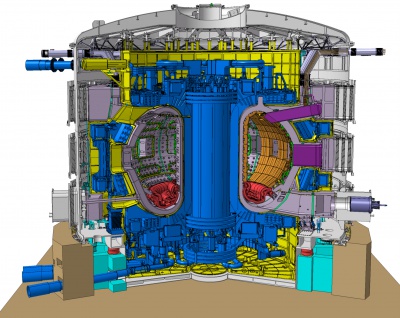ITER: Difference between revisions
Jump to navigation
Jump to search
| (25 intermediate revisions by the same user not shown) | |||
| Line 1: | Line 1: | ||
ITER is an international engineering and research project oriented towards demonstrating the technical and scientific viability of [[Nuclear fusion|fusion as an energy source]]. | |||
ITER is an international engineering and research project oriented towards demonstrating the technical and scientific viability of fusion as an energy source. | |||
For general background information on the project, refer to the [[:Wikipedia:ITER|Wikipedia]]. | For general background information on the project, refer to the [[:Wikipedia:ITER|Wikipedia]]. | ||
== Main specifications == | == Main specifications == | ||
ITER is a magnetic confinement device of the tokamak type. | ITER is a magnetic confinement device of the [[Tokamak|tokamak]] type. | ||
The reference operational scenario is the [[H-mode]] with the following characteristic parameters: | The reference operational scenario is the ELMy [[H-mode]] with the following characteristic parameters: | ||
<ref>[http://dx.doi.org/10.1088/0741-3335/44/5/304 R. Aymar et al, ''The ITER design'', Plasma Phys. Control. Fusion '''44''' (2002) 519-565]</ref> | <ref>[http://dx.doi.org/10.1088/0741-3335/44/5/304 R. Aymar et al, ''The ITER design'', Plasma Phys. Control. Fusion '''44''' (2002) 519-565]</ref> | ||
<ref>[http://dx.doi.org/10.1088/0741-3335/47/5A/003 A.C.C. Sips et al, ''Advanced scenarios for ITER operation'', Plasma Phys. Control. Fusion '''47''' (2005) A19-A40]</ref> | <ref>[http://dx.doi.org/10.1088/0741-3335/47/5A/003 A.C.C. Sips et al, ''Advanced scenarios for ITER operation'', Plasma Phys. Control. Fusion '''47''' (2005) A19-A40]</ref> | ||
[[File:ITER.jpg|400px|thumb|right|ITER design]] | |||
{| class="wikitable" align="center" border="1" | {| class="wikitable" align="center" border="1" | ||
| Line 25: | Line 26: | ||
|Confinement enhancement, H<sub>H98</sub>(y,2) || 1.0 | |Confinement enhancement, H<sub>H98</sub>(y,2) || 1.0 | ||
|- | |- | ||
|Normalised beta, β<sub>N</sub> || 1.8 | |[[Beta|Normalised beta]], β<sub>N</sub> || 1.8 | ||
|- | |- | ||
|Average electron density, <n<sub>e</sub>> (10<sup>19</sup>m<sup>-3</sup>) || 10.1 | |Average electron density, <n<sub>e</sub>> (10<sup>19</sup>m<sup>-3</sup>) || 10.1 | ||
|- | |- | ||
|Fraction of Greenwald limit, <n<sub>e</sub>>/n<sub>GW</sub> || 0.85 | |Fraction of [[Greenwald limit]], <n<sub>e</sub>>/n<sub>GW</sub> || 0.85 | ||
|- | |- | ||
|Average ion temperature, <T<sub>i</sub>> (keV) || 8.0 | |Average ion temperature, <T<sub>i</sub>> (keV) || 8.0 | ||
| Line 41: | Line 42: | ||
|Fusion power, P<sub>fusion</sub> (MW) || 400 | |Fusion power, P<sub>fusion</sub> (MW) || 400 | ||
|- | |- | ||
|Fusion gain, Q=P<sub>fusion</sub>/(P<sub>NB</sub>+P<sub>RF</sub>) || 10 | |[[:Wikipedia:Fusion_energy_gain_factor|Fusion gain]], Q=P<sub>fusion</sub>/(P<sub>NB</sub>+P<sub>RF</sub>) || 10 | ||
|- | |- | ||
|Non inductive current fraction, I<sub>NI</sub>/I<sub>p</sub> (%) || 28 | |Non inductive current fraction, I<sub>NI</sub>/I<sub>p</sub> (%) || 28 | ||
| Line 48: | Line 49: | ||
|} | |} | ||
In the standard scenario, part of the plasma current is inductively driven, so that operation is not steady state. Advanced scenarios seek to maximize pulse length by making use of the bootstrap current. | In the standard scenario, part of the plasma current is inductively driven, so that operation is not steady state. Advanced scenarios seek to maximize pulse length by making use of the [[Bootstrap current|bootstrap current]]. This may be achieved, e.g., by creating [[Internal Transport Barrier|Internal Transport Barriers]]. | ||
== Challenges == | == Challenges == | ||
=== Organizational === | |||
* Multiparty coordination | |||
=== Technical === | |||
* Avoidance and control of [[Disruption|disruptions]] | |||
* [[Edge Localized Modes|ELM]] mitigation | |||
* Heat load handling in the [[Divertor|divertor]] and on the wall | |||
* Radiation handling and wall materials | |||
=== Scientific === | |||
* Advanced operational scenarios (cf. [[Internal Transport Barrier]]) | |||
* Alpha and energetic particle physics | |||
* Diagnostic development | |||
== See also == | == See also == | ||
* [http://www.iter.org ITER website] | * [http://www.iter.org ITER website] | ||
* [http://www.efda.org/the_iter_project/index.htm EFDA: ITER] | |||
* [http://iopscience.iop.org/0029-5515/39/12 ''ITER Physics Basis'', Nucl. Fusion '''39''', 12 (1999)] | |||
== References == | == References == | ||
<references /> | <references /> | ||
[[Category:Toroidal confinement devices]] | |||
Latest revision as of 12:28, 19 August 2012
ITER is an international engineering and research project oriented towards demonstrating the technical and scientific viability of fusion as an energy source. For general background information on the project, refer to the Wikipedia.
Main specifications
ITER is a magnetic confinement device of the tokamak type. The reference operational scenario is the ELMy H-mode with the following characteristic parameters: [1] [2]
| Parameter | Value |
|---|---|
| Major radius, R0 (m) | 6.2 |
| Minor radius, a (m) | 2.0 |
| Toroidal field at R0, BT (T) | 5.3 |
| Plasma current, Ip (MA) | 15 |
| Edge safety factor, q95 | 3.0 |
| Confinement enhancement, HH98(y,2) | 1.0 |
| Normalised beta, βN | 1.8 |
| Average electron density, <ne> (1019m-3) | 10.1 |
| Fraction of Greenwald limit, <ne>/nGW | 0.85 |
| Average ion temperature, <Ti> (keV) | 8.0 |
| Average electron temperature, <Te> (keV) | 8.8 |
| Neutral beam power, PNB (MW) | 33 |
| RF power, PRF (MW) | 7 |
| Fusion power, Pfusion (MW) | 400 |
| Fusion gain, Q=Pfusion/(PNB+PRF) | 10 |
| Non inductive current fraction, INI/Ip (%) | 28 |
| Burn time (s) | 400 |
In the standard scenario, part of the plasma current is inductively driven, so that operation is not steady state. Advanced scenarios seek to maximize pulse length by making use of the bootstrap current. This may be achieved, e.g., by creating Internal Transport Barriers.
Challenges
Organizational
- Multiparty coordination
Technical
- Avoidance and control of disruptions
- ELM mitigation
- Heat load handling in the divertor and on the wall
- Radiation handling and wall materials
Scientific
- Advanced operational scenarios (cf. Internal Transport Barrier)
- Alpha and energetic particle physics
- Diagnostic development
